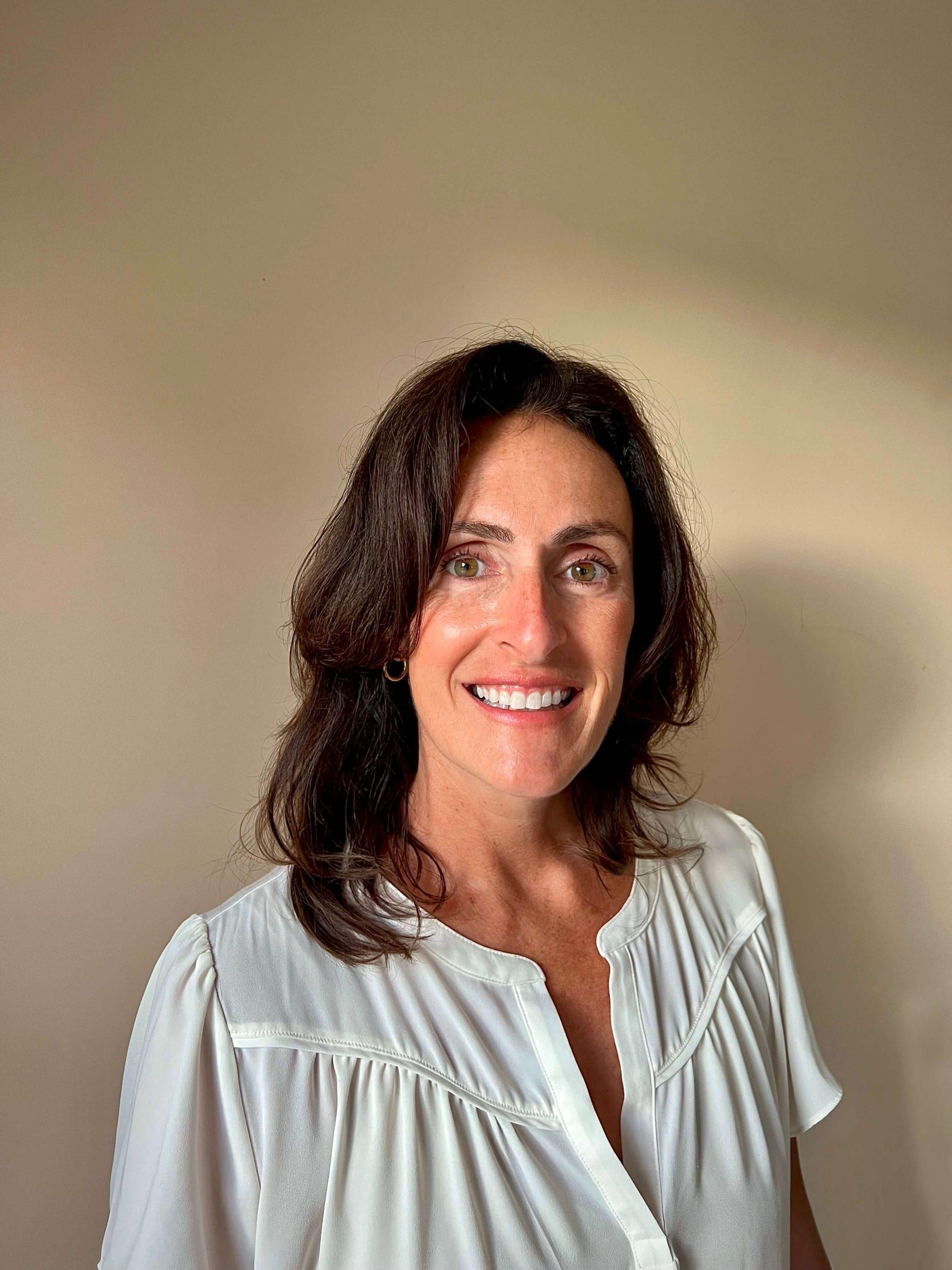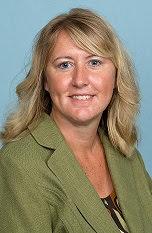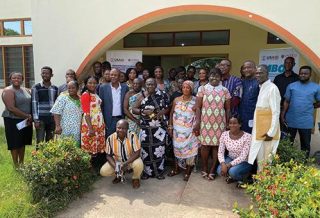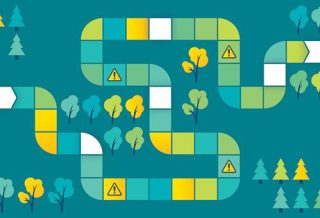FOCUS
COVID-19 reshaped new teacher induction — for the better
By Elizabeth Simons, Sheila B. Robinson and Marguerite Dimgba
Categories: Career pathways, Coaching, Continuous improvement, Facilitation, Implementation, Learning designs, Learning systems/planning, Mentoring & inductionAugust 2022
Each August, Greece Central School District, in northern New York, hosts a new teacher induction program for all new hires, designed by the director of professional learning and a large, diverse committee. The district’s longstanding new teacher induction model suddenly changed when the COVID-19 pandemic forced schools to close abruptly in March 2020.
Initially, we faced questions about how to prepare a remote program if we weren’t able to meet in person and how to support new teachers as they navigated a hybrid teaching model. When schools reopened, these challenges shifted, and new ones emerged.
The national teacher shortage that had been predicted for years began to impact our students directly, and experienced teachers began retiring or leaving in increasing numbers. We had a pronounced need for new teachers and faced the challenge of scaling our support to larger numbers.
As a result of these shifts, we rapidly transformed the way we support our new and novice teachers. Positive changes in how our district supports, develops expertise in, and retains highly qualified and satisfied new teachers are here to stay.
Understanding our teachers
The first step in adapting our support was understanding the teachers we are serving and how that has changed. “New teachers” is a bit of a misnomer. Our new hires come to Greece CSD with a wide variety and level of experiences, especially now.
Some are new to teaching, having just completed their college degrees. Since the pandemic, even this group has diverse needs because some have had in-person student teaching experiences, while others engaged in virtual classroom student teaching, and still others were unable to serve as student teachers at all.
Even if they have had student teaching experience, some new teachers are hired so late in the summer that they miss new teacher induction, teach an entire school year with us, and attend new teacher induction the following summer.
Other new teachers have had experience as long-term substitutes who have taught from a few weeks to nearly a full school year. We also hire experienced teachers from other districts, other states, and sometimes other countries, and these teachers have a wide range of teaching experiences, too.
COVID created another group of new teachers. New York State implemented an Emergency COVID-19 Certificate, which allows teacher candidates seeking certain certifications and extensions of existing certificates to work in the state’s public schools for two years while taking and passing the required exam(s) for the certificate or extension sought.
It is challenging to address all of these diverse experiences and needs. Making matters more challenging, the bulk of our new teacher induction program planning occurs before the end of the school year in June, while hiring continues right up through (and often past) the first day of school in September. Therefore, we don’t necessarily know about all of the individuals who will attend new teacher induction while we are organizing it. We factored all of these situations and needs into our planning as we considered how to modify our support going forward.
Reconsidering the structure
The need for virtual and hybrid models during the height of the pandemic spurred us to get creative about how we support new teachers, and that creativity has opened up new possibilities. At the same time, what is clear is that the most important thing is to be intentional about planning participants’ experiences so that, regardless of the method, our presenters are modeling best practices for instruction.
In August 2020, we hosted new teacher induction as a three-day hybrid professional learning program for 58 new teachers. We were in-person, socially distanced, and masked for the first two days, and we flipped Day Three and had everyone log in from home.
We started the day with a live synchronous streaming session, followed by a series of short asynchronous prerecorded sessions representing a mix of required and choice sessions. This hybrid model allowed us to be in person while limiting contact and following health guidelines.
The process of planning a hybrid model helped us to see that some content is more amenable to virtual than others. For example, for new teacher induction 2020, we abruptly shifted the content of Day Three that was appropriate for asynchronous instruction to become just that.
Much of this content was technology-related anyway, including familiarizing new teachers with the district’s learning management system and navigating the district website to find curriculum resources and everyday teacher applications (attendance, IEPs, communications, etc.). A data-based decision-making process that included feedback from previous attendees, stakeholders, and the planning committee helped inform such decisions.
Integrating technology
While planning virtual and hybrid components, we reached out to experts in technology integration. We learned a lot about the opportunities and challenges of educational technology and how to — and how not to — apply technological solutions.
For example, our technology integration teacher, Lynn Girolamo, taught us to think differently about how remote professional learning is different from our usual approaches. She said, “Technology provides an opportunity beyond the traditional sit-and-get workshop that crosses over, allowing more choice around pace, place, path, content. It really offers the opportunity for more differentiation than what we have traditionally been able to provide. So use technology to leverage opportunities for the choice and differentiation around asynchronous as well as synchronous opportunities.”
She also reminded us to always start with the learning goal instead of starting with the technology. She recommended asking ourselves: What problem can technology help us solve?
Moving forward, we see new teacher induction as a way to help teachers learn about the tools that are accessible and available to them and an opportunity to model how to use those tools in their classrooms. We also recognize that it is important to use only the technology that is available in the school district, even if these tools are not the latest and greatest. The new teachers need to grow savvy with the tools provided to ensure consistency across the system.
Teacher choice
Another important lesson we’ve learned during the pandemic is that teachers want and appreciate choice in professional learning. During the hybrid model we implemented in 2020, we created small-group options and choices among multiple asynchronous activities. Teachers responded positively, and we came to realize that teachers want choice not only in content, but also in time, place, and pace.
With this recognition, we are now able to meet the needs of a diverse new teacher cohort by offering them more choice options and effectively meeting them where they are, while at the same time preserving the required content we know they will need for success in our district.
For example, in the past, we brought in multiple speakers to share important regulations and initiatives with the new teachers. Instead, we invited these stakeholders to create videos and leverage technology in a way that provides the critical content while allowing for more choice in when and where this is accessed. New teachers found this more engaging and relevant, making these sessions meaningful learning experiences.
Expecting the unexpected
We have also learned how to be nimble and flexible, preparing as much as we can but pivoting when necessary. As one might expect, our hybrid plan incorporated a tremendous amount of technology, and with that came the inevitable glitches. But all the work we had done to be flexible paid off.
In one case, at the last minute, one of our speakers scheduled for a live presentation was forced to switch to a streaming presentation from her home due to health protocols that required family members of infected persons to quarantine. Since we were already set up for the hybrid presentation, we fairly seamlessly switched gears without losing much time.
Another incident did not work out as smoothly. We had to operate a session using a backup generator due to an emergency in the area. During the power outage, the scheduled session topic was culturally responsive teaching, and the heaviness of the atmosphere was exacerbated by the dimmed emergency lights and poor audio quality. This didn’t feel ideal.
Participant feedback indicated that this part of our program was important but that they had difficulty staying focused due to the audio and video problems associated with being on emergency power.
From this, we learned that we need to consider how particular content might make new teachers feel and make decisions about logistics accordingly. We already knew which topics were important to include in our new teacher induction agenda, but we learned to think differently about how to share these topics with people new to our organization and how to structure the environment to prepare for this.
We also learned to anticipate how to handle it when things go wrong, especially when working with a sensitive topic area. This thinking led us back to reflect on the purpose for every lesson and how to present it intentionally and supportively.
Moving forward
By August 2021, we had learned a lot from a year of dealing with COVID. With those lessons, and with updated pandemic restrictions and guidelines, we were able to create an intentional and effective approach to new teacher induction.
We offered three days of professional learning in person for 42 new teachers. For the first two days, things looked fairly normal (teachers sitting in table groups, working in pairs, live presenters), much the way new teacher induction had looked for years.
Everyone wore masks, but we were able to provide more opportunities for socializing than we did in 2020 because we now had the safety equipment to do so (plastic shields on tables, cleaning supplies readily available, and increased knowledge of COVID-19 protocols).
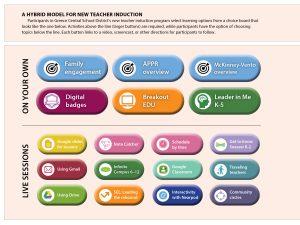
Day Three, however, was where we leaned into our new learning from the previous school year’s hybrid experience and featured both asynchronous and synchronous opportunities. Where possible, we made sections more flexible and incorporated choice. We created a type of choice board for participants to complete throughout their remote day. We designed it in a way that a participant would engage with some required topics and also have some measure of choice. (See figure above.)
Content that was not conducive to asynchronous learning was preserved as synchronous sessions. For example, we offered a synchronous session on how to be a traveling teacher assigned to multiple schools that was specifically offered to new teachers in those positions. This session was offered in two places at times throughout the day that would not conflict with any required sessions on the choice board.
The result of these adaptations was increased engagement among new teachers. The first year using the choice board, new teachers worked well beyond their summer academy day, digging into the plethora of materials and resources provided. This was unexpected and completely by teacher choice. The second year, similar results ensued. Evidence suggested that new teachers were able to access and dive deeper into the materials provided because we took away the limits of time, place, and pace.
Our program worked so well that, in one instance, a new teacher was COVID positive and at home but well enough to log in virtually on a district-issued device. A mentor teacher carried this new teacher around on their device throughout the day so that the new teacher would be able to participate and complete the new teacher induction program, a contractual requirement for employment in our district.
Doubling down on support
As the 2021-22 school year came to a close, a core new teacher induction planning team continued the work to flesh out the content and logistics of the program for fall 2022, drawing on the lessons we’ve learned over the past two school years.
This includes more tailored support. For example, when we discovered that the district had hired five new speech language pathologist teachers, we collaborated with the special education director to implement tailored learning opportunities for those new staff members during the three-day new teacher induction along with follow-up support during the school year.
This kind of collaboration with colleagues outside our department, both within and outside the district, is a high-leverage change that has come about because of the pandemic. Incorporating virtual meetings into our new normal has increased opportunities for collaboration between departments that traditionally have not had an opportunity to meet.
Never before had a problem of this magnitude rallied all members of our system in a way that forced collaboration and forged new connections. We were all learning new ways to meet people’s needs and found ourselves enthusiastic about sharing understandings.
These and other adaptations have helped our teacher retention rate continue to rise year over year, cumulatively by over 16% in the last five years — no small feat, given the wide range of experiences our new teachers bring and the major stresses they, and all teachers, have been facing.
At a time when many districts dropped their new teacher induction plans amid chaos and confusion, we were able to double down on our commitment to supporting new teachers. As we move forward, the lessons we have learned from the pandemic are preparing us to tackle future challenges, whatever they may be.
Categories: Career pathways, Coaching, Continuous improvement, Facilitation, Implementation, Learning designs, Learning systems/planning, Mentoring & induction
Recent Issues
WHERE TECHNOLOGY CAN TAKE US
April 2024
Technology is both a topic and a tool for professional learning. This...
EVALUATING PROFESSIONAL LEARNING
February 2024
How do you know your professional learning is working? This issue digs...
TAKING THE NEXT STEP
December 2023
Professional learning can open up new roles and challenges and help...
REACHING ALL LEARNERS
October 2023
Both special education and general education teachers need support to help...


